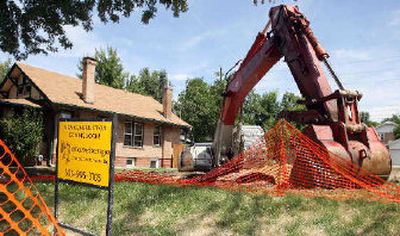McMansions move closer to city core

DENVER — Four summers ago at 7 a.m., the earth started moving and the ground shook, cracking the plaster in Jim Skelton’s small brick home.
The house next door was being torn down, another blow to what Skelton calls the character of Denver’s Platt Park neighborhood.
“They’re destroying what made this a neighborhood,” Skelton said.
McMansions. Faux chateaux. Scraping. Teardowns. All are becoming increasingly familiar terms across the nation. For years, tony suburbs like Kenilworth, Ill., Beverly Hills, Calif., and Westport, Conn., saw designer homes replaced by buildings two, three or four times as large.
Now, the trend is creeping from pricey, historical enclaves like Kenilworth and Denver’s Washington Park into middle-class bastions like Denver’s Platt Park and University Hills — aging tracts of 1,000-square-foot bungalows built from the ‘20s through the ‘50s. Some families weary of long commutes from the newer suburbs are turning back inward and remaking older neighborhoods to suit modern tastes.
While the teardown trend has slowed somewhat nationally because of the housing slump, bulldozers continue to roll in Denver: Home demolition permits numbered 198 in 2004, 352 in 2005, and were on track this year — 111 in the first five months of 2006.
The National Trust for Historic Preservation said teardowns threaten the character of 300 communities in 33 states, and that more than 75,000 homes are torn down and replaced with larger homes each year.
Ed Tombari, a land planner with the National Association of Home Builders, said critics of teardowns have it backwards.
“We perceive teardown housing as part of the overall smart growth strategy to direct development to the inner cities and to areas that already have infrastructure and public transportation,” Tombari said.
This urban trend is intensifying across the country, said Robert Lang, head of the Metropolitan Institute at Virginia Tech.
“Commutes are so long people are wanting places closer in,” he said. “‘I want a McMansion, but not out in McMansionville.”’
In Denver’s University Hills neighborhood, Drew Damiano bought a 3,394-square foot house for precisely that reason.
“It was a waste of an hour of my day that I could spend time with my kids,” said Damiano, who moved closer to downtown from its exurbia suburbs to the south.
Two years ago, Beverly Hills began imposing limits. The City Council said “mansionization” was a “serious danger” to the “character, image, beauty and reputation” of Beverly Hills, and the city developed a manual of proposed housing designs.
Lang said neighborhoods have several ways to control the spread of McMansions, but they need to build a consensus, propose reasonable alternatives and accept that some buildings should be replaced.
“Cities should be a little flexible,” he said.
Tombari concedes a big new house next to an old structure is going to look out of place. Special neighborhoods have a right to preserve their character, but activists are hijacking the move to stop all development, he said.
“There is an anti-construction element out there,” he said.
Bill Arhold, also of the University Hill neighborhood, did much of the work expanding his home to 1,750 square feet from 1,100.
“Still, I understand why seniors feel comfortable in homes they have lived in for most of their lives,” he said. “Then someone comes along and builds a two-story next to them, blocking the sun, raising their winter heating bills and killing their gardens.”